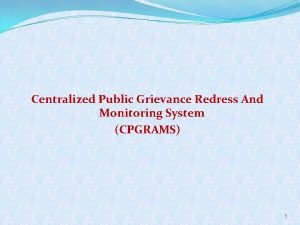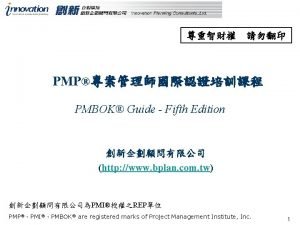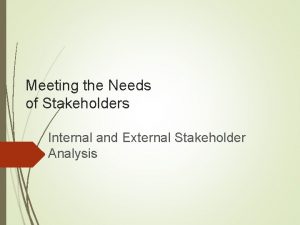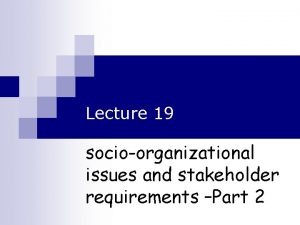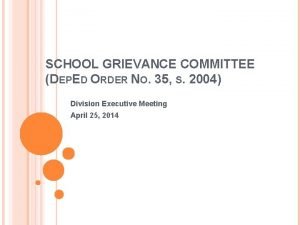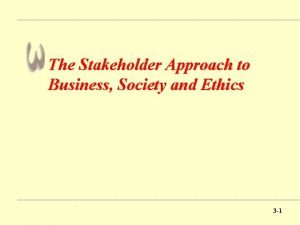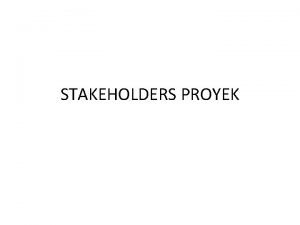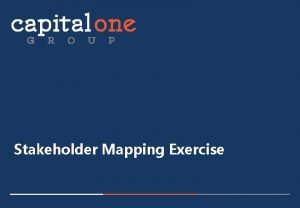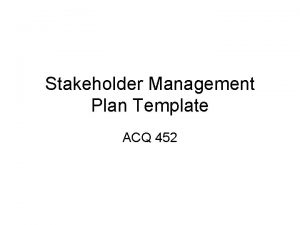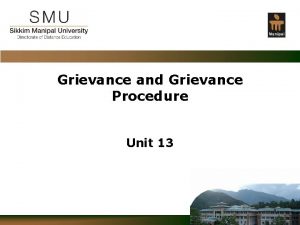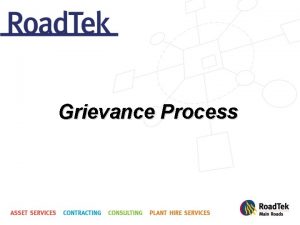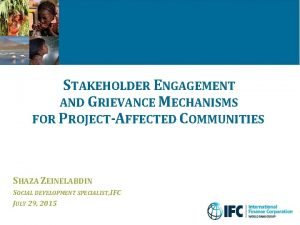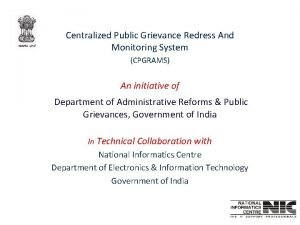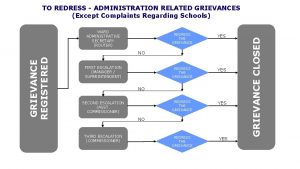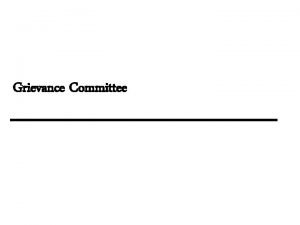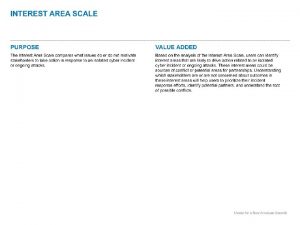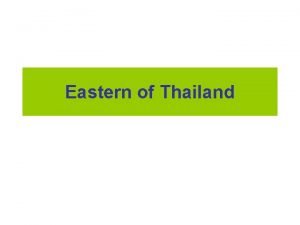Effective Grievance Redress and Stakeholder Engagement Mechanisms EASTERN



















- Slides: 19

Effective Grievance Redress and Stakeholder Engagement Mechanisms EASTERN AND SOUTHERN AFRICA HIGHER EDUCATION CENTERS OF EXCELLENCE 14 May 2018

Session Objectives • Understand Citizen/Community/Stakeholder Engagement and GRM • Appreciate the value add from application of GRM and CE • Understand the building blocks for effective Ces & GRMs • Engaged Exercise: Rate our Project GRMs against Best Practice • Managing Gender Based Violence through GRMs 2

Grievance Redress Mechanism and Citizen Engagement GRM- A system by which, complaints and dissatisfaction arising out of implementation are communicated, tracked and are resolved in the most efficient manner Benefits • Reduce the likeliness of escalation of disputes • Identify and address potential negative impacts, unanticipated issues • Improve results and lessons learned Citizen Engagement- Two-way interaction between citizens and the project which give citizens a stake in decision-making with the objective to improve intermediate and final projects outcomes. CE is about creating Feedback Loops between Citizens and the Project 3

Closing the Feedback Loop Dimensions of citizen engagement

Volunteer Activity Q. If you had an opportunity to influence your Country’s or University consultation/ feedback /conflict resolution system, what would be the five improvements you propose?

Principles of Effective GRMs Fairness- Grievances are treated confidentially, assessed impartially, and handled transparently. Objectivity and independence The GRM operates independently of all interested parties in order to guarantee fair, objective, and impartial treatment to each case. GRM officials have adequate means and powers to investigate grievances (e. g. , interview witnesses, access records). Simplicity and accessibility Procedures to file grievances and seek action are simple enough that project beneficiaries can easily understand them. The GRM is accessible to all stakeholders, irrespective of the remoteness of the area they live in, the language they speak, and their level of education or income 6

Principles of Effective GRMs Responsiveness and efficiency- The GRM is designed to be responsive to the needs of all complainants. Accordingly, officials handling grievances are trained to take effective action upon, and respond quickly to, grievances and suggestions. Speed and proportionality- All grievances, simple or complex, are addressed and resolved as quickly as possible. The action taken on the grievance or suggestion is swift, decisive, and constructive. Participatory and social inclusion- Special attention is given to ensure that poor people and marginalized groups, including those with special needs, are able to access the GRM. 7

The World Bank’s Grievance Management Structure High Low Accountability Low 8 Grievance Redress Inspection Service (GRS) Panel (IPN) Promptness in Problem Solving Project-level Grievance Redress Mechanisms (GRM) Project-level GRMs often have the advantage of being (i) close to the 8 affected community, (ii) tailored to the project’s expected impacts, and (iii) potentially able provide quick resolution High

Steps in Setting Up a Basic GRM Area Activities Complaint Receipt • Assign a specific email id, phone number. • Set up an easy to access "Suggestion/Grievance box”. • Designate a grievance officer to receive, log, monitor or track grievances • Modify the project website (if any) to create a permanent sub-window that facilitates collection of complaints. Complaint Processing • Suggest timeframes and procedures to receive, log, monitor or track complaints and respond to complainants. • Assign grievance resolution responsibilities to existing staff Monitoring and Tracking Complaints • Design a simple, easy to use, excel-based or log-book based complaint registration and monitoring database • Regularly review feedback received, cases resolved and complaints trends in resettlement review meetings.

GRM Value Chain • Uptake - How are grievances collected? At how many locations and through what channels? What is the organizational structure for grievances handling? • Sorting and Processing – How are grievances categorized, logged and prioritized? Who are they referred to? How are they addressed? • Acknowledgement and Follow Up – Are complainants provided receipts? How are they provided progress updates? • Verification, Investigation and Action – How is information about the grievance gathered to resolve it? How are grievances escalated to higher levels? • Monitoring and Evaluation – How are grievances tracked? How is grievances data analyzed? How are processes modified to prevent grievances from recurring? • Feedback – How are GRM users and the public at large informed about the results of investigations and the actions taken on grievances?

Common Challenges • Project-level GRMs often do not build upon existing in-country grievance redress systems and/or focus only on specific topics (procurement, resettlement) and have a life-span tied to project implementation • Complainants hesitate in raising sensitive issues due to a number of factors (cultural, social, economic and political); anonymity, confidentiality and protection from retribution often cannot be guaranteed • Reluctance of project implementing entities to pick up complains due to associated extra cost and delays • Fear that a large number of grievances will undermine public image of project • Inter-departmental coordination, that is critical for resolution, often difficult • While setting up GRMs, focus is often on front-end activities (website, communication, etc. ) rather than the back-end (SOPs; integrated databases) leading to poor resolution thereby undermining trust

Gender Based Violence (GBV) Awareness and Reporting Gender Based Violence -- an umbrella term for any harmful act that is perpetrated against a person’s will and that is based on socially ascribed (i. e. gender) differences between males and females. It includes acts that inflict physical, sexual or mental harm or suffering, threats of such acts, coercion, and other deprivations of liberty Sexual harassment (SH)- Unwelcome sexual advances, requests for sexual favors, and other unwanted verbal or physical conduct of a sexual nature. SH differs from SEA in that it occurs between personnel/staff working on the project, and not between staff and project beneficiaries or communities Sexual Exploitation and Abuse (SEA) - Any actual or attempted abuse of a position of vulnerability, differential power, or trust, for sexual purposes, including, but not limited to, profiting monetarily, socially or politically from the sexual exploitation of another. 12

Recommendations for Addressing Gender Based Violence • Be survivor-centered- protecting the confidentiality of survivors, recognizing them as principle decision-makers in their own care and treating them with agency, dignity and respect for their needs and wishes • Emphasize prevention: Adopt risk-based approaches that aim to identify key risks of GBV and to undertake measures to prevent or minimize harm. • Build on existing local knowledge: Engage community partners—local leaders, civil society organizations, gender and child advocates— as resources for knowledge on local level risks, effective protective factors and mechanisms for support throughout the project cycle. Be adaptable- Operational guidance is just the foundation- adapt and adjust mitigation measures to respond to the unique drivers and context in any given setting. • • Enable continuous monitoring and learning: Ensure operations integrate mechanisms for regular monitoring and feedback to track effectiveness and to build internal knowledge of what works to prevent, mitigate and respond to GBV 13

GRM Dos and Don’ts 1. Uptake • Dos ü Create accessible uptake locations and channels • ü Maintain log books at various levels to record all complaints, inquiries, and suggestions received. ü Publicize uptake options/contact information on communication materials, in offices, etc. • Don’ts ü Create barriers to complaining by making uptake processes time consuming or complicated ü Forget to take measures to ensure that vulnerable groups are able to access the GRM 14

GRM Dos and Don’ts 2. Monitor and evaluate • Dos ü Signal importance of complaints handling putting topic as agenda item for management meetings ü Establish a tracking system to record, classify, and assess complaints ü Analyze grievance redress data and make improvements • Don’ts ü Miss the opportunity to integrate the GRM into the project’s management information system ü View the resolution of complaints as an end in itself—it is just a first step in improving processes 15

GRM Dos and Don’ts 4. Provide feedback • Dos ü Contact users to explain how their complaint was resolved and how they can appeal ü Publicize results of investigations to enhance visibility of and increase trust in the GRM • Don’ts ü Neglect to follow up with users; this undermines trust in the GRM ü Keep complaint results private; this undermines transparency 16

GRM Dos and Don’ts 3. Sort and process • Dos ü Clearly outline who is responsible for handling different types of complaints ü Establish clear timetables for the complaints-handling process ü Assign each complaint a unique ID number • Don’ts ü Leave any ambiguity about how complaints are supposed to be routed ü Develop a GRM that does not differentiate between different types of complaints 17

The value add from applying GRM and SE SAFETY INCLUSIVITY Safety Inclusivity Accountabi lity ACCOUNTABILITY • Gender Inclusion • Cultural inclusion • Disability Inclusion • Stakeholder and Community Engagement • Grievance Redress Mechanism 18

Thank you!
 Cpgrams
Cpgrams Iso stakeholder engagement
Iso stakeholder engagement Managing stakeholder engagement
Managing stakeholder engagement Design of experiments pmp
Design of experiments pmp Creating your own declaration of independence
Creating your own declaration of independence Business and society ethics and stakeholder management
Business and society ethics and stakeholder management Stakeholders internal and external
Stakeholders internal and external Catwoen
Catwoen Roles and responsibilities of grievance committee in school
Roles and responsibilities of grievance committee in school Grievance romeo and juliet
Grievance romeo and juliet Whats a stake holder
Whats a stake holder Anspruchsgruppen
Anspruchsgruppen Stakeholder priority matrix
Stakeholder priority matrix What are the principles of stakeholder management
What are the principles of stakeholder management Stakeholder register
Stakeholder register Stakeholder priority matrix
Stakeholder priority matrix Stakeholder analysis fashion industry
Stakeholder analysis fashion industry Stakeholder proyek
Stakeholder proyek Keep satisfied manage closely monitor keep informed
Keep satisfied manage closely monitor keep informed Stakeholder management plan template
Stakeholder management plan template
